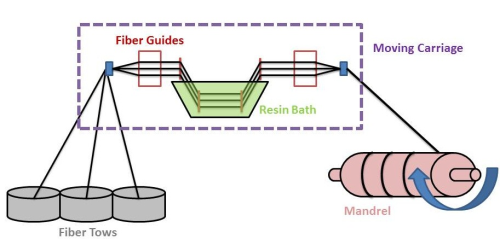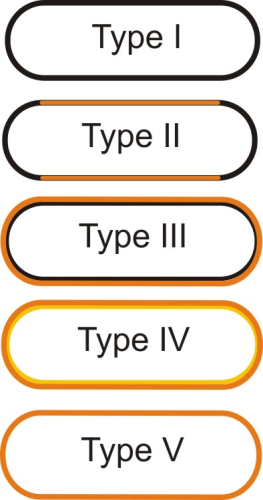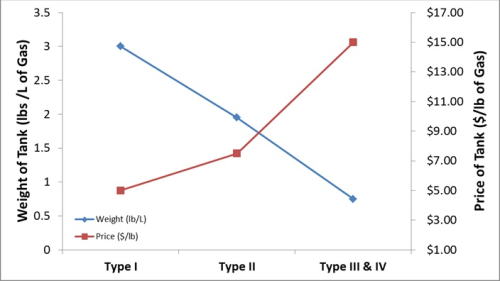



The benefits of lightweight composites in transportation are generally known when it comes to the interior and minor body components of an automobile. However, in the broader sense of transportation, there is another attractive application in the area of energy storage. While the most common application of composite pressure vessels is in the storage of gas for combustion in the engine system of motor vehicles, other applications exist such as the transportation of compressed gas in large cylinders. Additional advantages of composite pressure vessels are related to safety, thanks to high impact strength, anti-explosion failure modes and corrosion-free attributes. Outside transportation applications, composite liquefied petroleum gas (LPG) tanks are increasingly used as energy sources for professional or private cooking and community kitchens.
In terms of fabrication, composite pressure vessels are mainly produced using wet filament winding processing with glass or carbon fibres impregnated with epoxy matrix material or other resin types. The wide range of viscosities, working time and excellent thermo-mechanical properties are the main reasons why epoxies are the widely accepted resins of choice. Filament winding is, in general, one of the most important composite manufacturing processes with respect to the number of users and total number of manufactured parts. A number of tank-type storage devices are manufactured in this way including chemical storage tanks and pressure vessels for various uses, such as breathing apparatus and fire extinguishers.
Filament winding: how a composites cylinder comes to life
The filament winding process begins with fibre rovings coming from spools of glass, carbon, aramid, etc. - fibres mounted on a creel. The fibres are gathered together and collected through a type of fibre guide (i.e. comb, designated by ‘Fibre Guides’ in Figure 1). The number of the fibres brought together determines the band width. The band is pulled through the resin bath (resin and hardener is mixed so that the system is active, shown by ‘Resin Bath’ in Figure 1) where the resin interpenetrates the pulled fibre rovings. The fibres are then drawn through a roller or wiper system to achieve the desired resin content and drawn through a pay-off point (second red box in Figure 1). The payoff stand is the point at which the fibre contacts the moving carriage and directs the fibre on to the rotating mandrel (blue box on far right of Figure 1). Once the winding is complete the tank is usually cured through a heating process before manufacturing is considered complete. An increasingly important application of filament-wound tanks is the storage of pressurised gases such as compressed natural gas (CNG) and liquefied petroleum gas (LPG) for energy storage. Pressure vessels are typically categorised five ways, four of which utilise filament winding as part of the manufacturing process:
- Type I: All metal construction, usually steel. No composite reinforcement.
- Type II: Mostly metal (aluminium or steel) construction with some fibre over wrap in the hoop direction.
- Type III: Metal liner (usually aluminium) with full composite overwrap.
- Type IV: Polymer liner (usually polyamide or polyethylene-based) with an all composite overwrap. The composite handles all of the stresses of the pressurised liquid or gas.
- Type V: No liner. All composite construction through winding. The composite handles all of the stresses of the pressurised liquid or gas as well as containment.
Type I pressure vessels are by far the most used form of pressure vessels and account for roughly 90% of the total pressure vessel market but these also tend to be very heavy when compared to their Type III and Type IV composite counterpart (see Figure 3). The weight reduction between a Type I and a Type III or Type IV pressure vessel and the associated cost increase is shown in Figure 3. Furthermore, composite reinforced pressure vessels allow for higher operating pressures for higher energy storage density. Very few Type V pressure vessels do exist so far, one such vessel was manufactured by Composites Technology Development, Inc. for use on the US Formation Autonomy Spacecraft 1 (FASTRAC) satellite. There are costs and performance trade-offs with each type of construction depending on the specific needs of the customer, but general trends indicate a shift to Type III, IV and V composite reinforced pressure vessels because of the associated performance gain.
Meeting growing demand with production efficiency
The market dynamics of the oil and gas industry and the increasing regulatory pressure on the reduction of vehicle emissions has brought heightened attention from a number of countries globally on exploiting their natural gas resources. This is being done by investing in the necessary natural gas recovery infrastructure and storage as well as pushing final end use applications. Hence, the global Natural Gas Vehicle Association reports on average a higher than 20% annual growth of natural gas vehicles (NGV) worldwide, with a rate of 3-4 million new natural gas-empowered vehicles being produced every year and with an annual growth rate of composite pressure vessels of roughly 13-14% [1]. In particular, given the recent natural gas boom in the United States and the increasing demand for lightweight pressure vessels for automotive applications worldwide, a number of demand-related issues have arisen. Production demand for both small and large storage tanks have skyrocketed prompting current manufacturers to increase production and new manufacturers to enter the arena. Most of the production of composite pressure vessels has been concentrated in the hands of a small group of players thus far, but with the currently growing demand the field will open up the field for a larger number of manufacturers and increased customisation is likely. Market pressure on the manufacture of pressure vessels is putting stress on the current production infrastructure. However, the production volume increase alone will not be enough to satisfy future demand so it is important to focus on improving production technology in parallel with volume expansion. Product technology can be improved at a number of points along the production process including but not limited to chemistry, reinforcements and fillers. One of the main needs for filament wound pressurised vessels is in the automotive industry where the transportation and storage of LPG and CNG cylinders is becoming more and more commonplace. With the increasing demand for these cylinders, larger quantities (and higher pressure grades) of natural gas are being transported over longer distances placing additional pressure on current infrastructure and safety regulations. Additionally, smaller composite pressure vessels are being used in a number of automotive applications that yield different concerns not yet addressed such as increased lifespan and conformable tanks for non-circular tanks. To counteract these pressures, the global composites industry and supporting infrastructure can use a customer-focused research and development approach to improve the durability of filament wound pressure vessels.
References
1. “Growth Opportunities in Global Composites Industry 2013-2018.” Lucintel Report, March 2013
See Part 2 of Lightweighting matters in energy storage
This article was published in the July/August 2014 issue of Reinforced Plastics magazine.
The digital edition of Reinforced Plastics is distributed free of charge to readers who meet our qualifying criteria. You can apply to receive your free copy by completing this short registration form.






